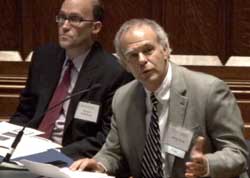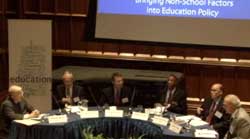Filed Under > Policy
A Consensus that Poverty Really Does Influence Education Outcomes
At a recent TC gathering of top education researchers, the consensus was that poverty really does influence educational outcomes
By Patricia Lamiell
Education, like any field, has its pendulum swings, and nowhere more so than around the issue of poverty.
In 1966, the federal government released “Equality of Educational Opportunity,” the first comprehensive national study to name poverty and its related problems—unstable housing, poor nutrition, lack of health care—as a cause of failure in school. Better known as The Coleman Report (for its principal author, Johns Hopkins University sociologist James Coleman), the document became the foundation of federal education policy for the next 35 years.
Beginning in about 2000, some education reformers began arguing that schools should be able to teach any child, regardless of his or her background. The legislation that emerged in part from their work—the federal No Child Left Behind Act, signed into law by President George W. Bush in 2002 – garnered widespread bipartisan support because it seemingly promised to hold schools accountable for imparting a quality education to students from historically neglected groups, including many minorities and those from low-income families.
However, most observers now agree that the 2014 deadline set by NCLB for states to ensure proficiency for all American children in literacy and math, with no accompanying resource allocation and no clear or universal definition of “proficiency,” had the reverse effect of what was intended. At best, many school districts narrowed their focus academic focus and “taught to the test,” while others actively gamed the system, “counseling out” poor students or otherwise disguising low test scores.
Now the pendulum shows signs of swinging back. Recently, bolstered in part by a growing body of empirical evidence that confirms that income status really does have a major impact on academic success—and that poverty is a problem for which schools alone cannot be held accountable—many states have secured waivers that excuse them from complying with NCLB in exchange for making changes that were being pushed by the U.S. Department of Education.
On September 19, at an event titled “Beyond the Schoolhouse Door: Bringing Non-School Factors Into Education Policy,” the prominent scholars and editors of three comprehensive volumes published this year gathered in TC’s Milbank Chapel to discuss the latest research on the connection between poverty and education and the implications for policy. The speakers also sought to handicap the political chances of those policies in this presidential election year.
See the video for Beyond the Schoolhouse Door: Bringing Non-School Factors Into Education Policy

